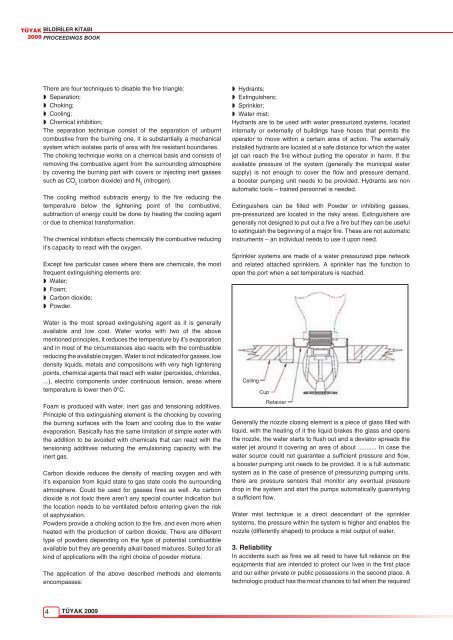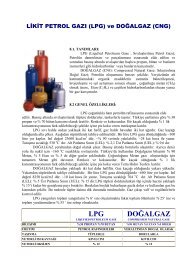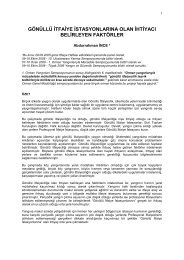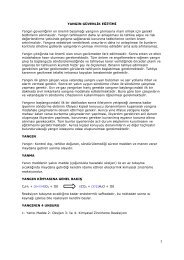buradan - Yangın
buradan - Yangın
buradan - Yangın
You also want an ePaper? Increase the reach of your titles
YUMPU automatically turns print PDFs into web optimized ePapers that Google loves.
TÜYAK BİLDİRİLER KİTABI<br />
2009 PROCEEDINGS BOOK<br />
There are four techniques to disable the fire triangle:<br />
w Separation;<br />
w Choking;<br />
w Cooling;<br />
w Chemical inhibition;<br />
The separation technique consist of the separation of unburnt<br />
combustive from the burning one, it is substantially a mechanical<br />
system which isolates parts of area with fire resistant boundaries.<br />
The choking technique works on a chemical basis and consists of<br />
removing the combustive agent from the surrounding atmosphere<br />
by covering the burning part with covers or injecting inert gasses<br />
such as CO 2 (carbon dioxide) and N 2 (nitrogen).<br />
The cooling method subtracts energy to the fire reducing the<br />
temperature below the lightening point of the combustive,<br />
subtraction of energy could be done by heating the cooling agent<br />
or due to chemical transformation.<br />
The chemical inhibition effects chemically the combustive reducing<br />
it’s capacity to react with the oxygen.<br />
Except few particular cases where there are chemicals, the most<br />
frequent extinguishing elements are:<br />
w Water;<br />
w Foam;<br />
w Carbon dioxide;<br />
w Powder.<br />
Water is the most spread extinguishing agent as it is generally<br />
available and low cost. Water works with two of the above<br />
mentioned principles, it reduces the temperature by it’s evaporation<br />
and in most of the circumstances also reacts with the combustible<br />
reducing the available oxygen. Water is not indicated for gasses, low<br />
density liquids, metals and compositions with very high lightening<br />
points, chemical agents that react with water (peroxides, chlorides,<br />
...), electric components under continuous tension, areas where<br />
temperature is lower then 0°C.<br />
Foam is produced with water, inert gas and tensioning additives.<br />
Principle of this extinguishing element is the chocking by covering<br />
the burning surfaces with the foam and cooling due to the water<br />
evaporation. Basically has the same limitation of simple water with<br />
the addition to be avoided with chemicals that can react with the<br />
tensioning additives reducing the emulsioning capacity with the<br />
inert gas.<br />
Carbon dioxide reduces the density of reacting oxygen and with<br />
it’s expansion from liquid state to gas state cools the surrounding<br />
atmosphere. Could be used for gasses fires as well. As carbon<br />
dioxide is not toxic there aren’t any special counter indication but<br />
the location needs to be ventilated before entering given the risk<br />
of asphyxiation.<br />
Powders provide a choking action to the fire, and even more when<br />
heated with the production of carbon dioxide. There are different<br />
type of powders depending on the type of potential combustible<br />
available but they are generally alkali based mixtures. Suited for all<br />
kind of applications with the right choice of powder mixture.<br />
The application of the above described methods and elements<br />
encompasses:<br />
4<br />
TÜYAK 2009<br />
w Hydrants;<br />
w Extinguishers;<br />
w Sprinkler;<br />
w Water mist;<br />
Hydrants are to be used with water pressurized systems, located<br />
internally or externally of buildings have hoses that permits the<br />
operator to move within a certain area of action. The externally<br />
installed hydrants are located at a safe distance for which the water<br />
jet can reach the fire without putting the operator in harm. If the<br />
available pressure of the system (generally the municipal water<br />
supply) is not enough to cover the flow and pressure demand,<br />
a booster pumping unit needs to be provided. Hydrants are non<br />
automatic tools – trained personnel is needed.<br />
Extinguishers can be filled with Powder or inhibiting gasses,<br />
pre-pressurized are located in the risky areas. Extinguishers are<br />
generally not designed to put out a fire a fire but they can be useful<br />
to extinguish the beginning of a major fire. These are not automatic<br />
instruments – an individual needs to use it upon need.<br />
Sprinkler systems are made of a water pressurized pipe network<br />
and related attached sprinklers. A sprinkler has the function to<br />
open the port when a set temperature is reached.<br />
Ceiling<br />
Cup<br />
Retainer<br />
Generally the nozzle closing element is a piece of glass filled with<br />
liquid, with the heating of it the liquid brakes the glass and opens<br />
the nozzle, the water starts to flush out and a deviator spreads the<br />
water jet around it covering an area of about ........... In case the<br />
water source could not guarantee a sufficient pressure and flow,<br />
a booster pumping unit needs to be provided. It is a full automatic<br />
system as in the case of presence of pressurizing pumping units,<br />
there are pressure sensors that monitor any eventual pressure<br />
drop in the system and start the pumps automatically guarantying<br />
a sufficient flow.<br />
Water mist technique is a direct descendant of the sprinkler<br />
systems, the pressure within the system is higher and enables the<br />
nozzle (differently shaped) to produce a mist output of water.<br />
3. Reliability<br />
In accidents such as fires we all need to have full reliance on the<br />
equipments that are intended to protect our lives in the first place<br />
and our either private or public possessions in the second place. A<br />
technologic product has the most chances to fail when the required





